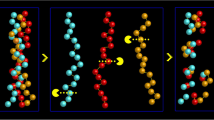Abstract
A selection of NSAID's and diphosphonates were studied in a tissue culture model of cartilage degradation utilising porcine synovium and bovine nasal cartilage. All the NSAID's significantly reduced cartilage degradation when incorporated into the synovial culture medium. Lesser reductions were recorded when preformed chondrocyte stimulating factors were used and NSAID's added at the cartilage assay stage. These findings suggested that the principle site of action of NSAID's is upon the production of chondrocyte stimulating factors. None of the NSAID's tested affected inherent cartilage degradation. Diphosphonates had the opposite effects, they increased inherent cartilage degradation but had no effect on chondrocyte mediated cartilage degradation. The relationship of these results to previous known effects of NSAID's and diphosphonates upon cartilage is discussed. In addition, correlations between chondrocyte stimulating factors, catabolin and interleukin 1 are made.
Similar content being viewed by others
References
J.T. Dingle,Catabolin. A cartilage catabolic factor from synovium. Clin. Orth.156, 219–231 (1981).
H. Sheppeard, L.M.C. Pilsworth, B. Hazleman, J.T. Dingle.Effects of antirheumatoid drugs on the production and action of porcine catabolin, Ann. Rheum. Dis.41, 463–468 (1982).
M.J. Crossley, I.M. Honeyball,The action of antirheumatic drugs on cartilage matrix degradation in co-cultures of synovium and cartilage in vitro, p. 34, Symposium on cellular interactions, Strangeways Laboratories, Cambridge, September (1980).
J. Steinberg, S. Tsukamoto, C. Sledge.A tissue culture model of cartilage breakdown in rheumatoid arthritis. III Effects of antirheumatic drugs. Arth. Rheum.22, 877–885 (1979).
J. Saklatvala.Characterization of catabolin, the major product of pig synovial tissue that induces resorption of cartilage proteoglycan in vitro. Biochem. J.199, 705–714 (1981).
L. Flora,Comparitive anti-inflammatory and bone protective effects of two diphosphonates in adjuvant arthritis. Arth. Rheum.22, 340–346 (1979).
R.W. Farndale, C.A. Sayers, A.J. Barrett.A direct spectrophotometric microassay for sulphated glycosaminoglycans in cartilage cultures. Conn. Tiss. Res.9, 247–248 (1982).
J.T. Dingle, J. Saklatvala, R. Hembry, J. Tyler, H.B. Fell, R. Jubb.A cartilage catabolic factor from synovium. Biochem. J.184, 177–180 (1979).
J. Saklatvala, V.A. Curry, S.J. Sarsfield.Purification to homogeneity of pig leucocyte catabolin, a protein that causes cartilage resorption in vitro. Biochem. J.215, 385–392 (1983).
H.E. Jasin, J.T. Dingle.Human mononuclear cell factors mediate cartilage matrix degradation through chondrocyte activation. J. Clin. Invest.68, 571–581 (1981).
L.M.C. Pilsworth, J. Saklatvala.The cartilage resorbing protein catabolin is made by synovial fibroblasts and its production is increased by phorbol myristate acetate. Biochem. J.216, 481–489 (1983).
J. Saklatvala, L.M.C. Pilsworth, S.J. Sarsfield, J. Gavrilovic, J.K. Heath.Pig catabolin is a form of interleukin 1. Biochem. J.224, 461–466 (1984).
R.W. Jubb.Breakdown of articular cartilage by vascular tissue. J. Path.136, 333–343 (1982).
J.A. Tyler, H.B. Fell, C.E. Lawrence.Effect of cortisol on porcine articular tissues in organ culture. J. Path.137, 335–351 (1982).
M. Palmoski, K. Brandt.Effects of diphosponate on glycosaminoglycan synthesis and proteoglycan aggregation in normal adult articular cartilage. Arth. Rheum.21, 942–949 (1978).
D.P. Simmons, O.D. Chrisman,Salicylate inhibition of cartilage degradation. Arth. Rheum.8, 960–969 (1965).
G. Bentley.Articular cartilage studies and osteoarthritis. Ann. Roy. Coll. Surg. (Eng.)57, 86–100 (1975).
M. Palmoski, K. Brandt.Relationship between matrix proteoglycan content and the effects of salicylate and indomethacin on articular cartilage. Arth. Rheum.26, 528–531 (1983).
R.W. Jubb.Non-steroidal anti-inflammatory drugs and articular cartilage. Curr. Med. Lit.-Rheumatology3, 6–8 (1984).
K.D. Rainsford.Preliminary investigations on the pharmacological control of catbolin induced cartilage destruction in vitro. Agents and Actions16, 1–3 (1985).
M.K.B. McGuire, R.G.G. Russell, G. Murphy, J.J. Reynolds.Disphosphonates inhibit production of prostaglandins and collagenase by human cells in vitro. Ann. Rheum. Dis.40, 515 (1981).
O.L.M. Bijvoet, W.B. Frijlink, K. Jie, H. v.d. Linden et al.APD in Paget's disease of the bone. Arth Rheum23, 1193–1204 (1980).
P.R. Elford, J.E. Meats, R.M. Sharrard, R.G. Russell.Partial purification of a factor from human synovium that possesses interleukin 1, chondrocyte stimulating and catabolin like activities. FEBS letters179, 247–251 (1985).
R.G.G. Russell.Discussion in “Diphosphonates: History and mechanisms of action. Br. J. Clin. Pract., Symposium suppl.13, 44–45 (1981).
H. Sheppeard, K. Couchman.Experience with Isoxicam and catabolin. J. Clin. Pharm. in the press (1985).
J.H. Herman, A.M. Appel, E.V. Hess.Piroxicam modulation of the synthesis and activity of catabolin produced by osteoarthritic and rheumatoid synovium. Arth. Rheum.27 (suppl), Abst B 38 (1984).
J. Panagides, M.J. Landes, A.E. Sloboda.Destruction of articular cartilage by arthritic synovium in vitro: mechanism of breakdown and effect of indomethacin and prednisolone. Agents Actions10, 22 (1980).
R.S. Decker, J.T. Dingle.Cardiac catabolic factors: The degradation of heart valve intercellular matrix. Science215, 987–989 (1982).
Author information
Authors and Affiliations
Rights and permissions
About this article
Cite this article
Couchman, K.G., Sheppeard, H. The effect of anti-rheumatic drugs on factors from porcine synovium inducing chondrocyte mediated cartilage degradation. Agents and Actions 19, 116–122 (1986). https://doi.org/10.1007/BF01977266
Received:
Revised:
Accepted:
Issue Date:
DOI: https://doi.org/10.1007/BF01977266




